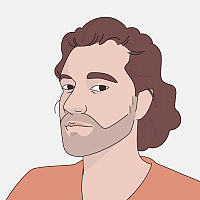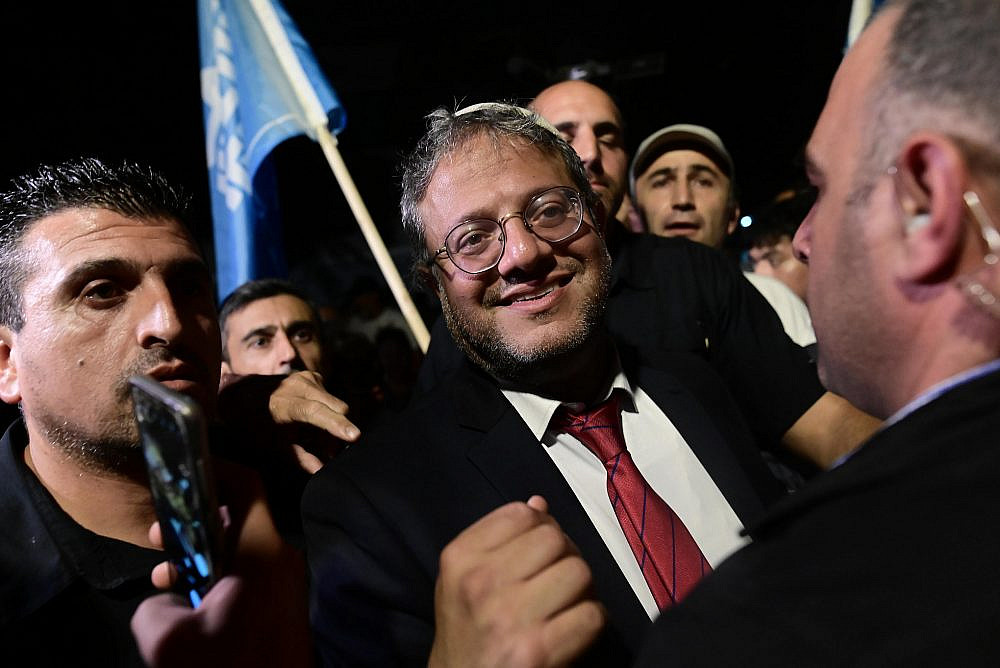It was already dark by the time Itamar Ben Gvir arrived in south Tel Aviv’s De Modena Park last Wednesday evening. The energy had been steadily building since the early afternoon, as crowds of the far-right politician’s supporters and detractors gathered in anticipation of his arrival, vying over who could make more noise. The arrival of another Knesset member from Ben Gvir’s Religious Zionism list, Simcha Rothman, had caused a minor commotion in the right-wing camp an hour earlier. But it was abundantly clear who everyone had really come to see.
Ben Gvir’s star has been on the rise ever since he entered the Knesset a year and a half ago, with his unabashed racism and public provocations capturing the media spotlight and garnering unprecedented levels of support for his Kahanist ideology. Now second-in-command of the list that looks set to be the third largest in the Knesset come the election on Nov. 1, Ben Gvir will almost certainly become a government minister should the bloc led by former prime minister Benjamin Netanyahu receive enough seats to form a coalition.
With the election only weeks away, the gathering at De Modena Park was, in many ways, the perfect campaign event. When he finally arrived, two hours later than originally advertised, Ben Gvir was immediately swarmed by dozens of adoring supporters who could no longer contain their excitement. Nor could he.
Smiling and waving, a flood of momentum swept him into the park through an entrance that police had tried to cordon off to prevent friction with the left-wing camp, who greeted him with horns, drums, screams of “fascist!” and the contents of a water bottle. Even the dozens of heavily-armed Border Police officers, who had spent most of the afternoon posing for the unit’s official photographer, seemed totally unprepared for the intensity of emotion that Ben Gvir’s presence suddenly unleashed.
Making the country unlivable
The invitation to the event, publicized on social media a few days earlier, had called on residents of south Tel Aviv to join Ben Gvir, Rothman, and Sheffi Paz — the self-appointed leader of the so-called “South Tel Aviv Liberation Front,” who has made a name for herself harassing and attacking African asylum seekers and their children in the city — in a “solidarity sukkah” in the Shapira neighborhood, to mark the Jewish festival of Sukkot. De Modena Park was chosen specifically because, the invitation said, it “has become a symbol of the Eritrean-Sudanese occupation in the heart of Shapira.”
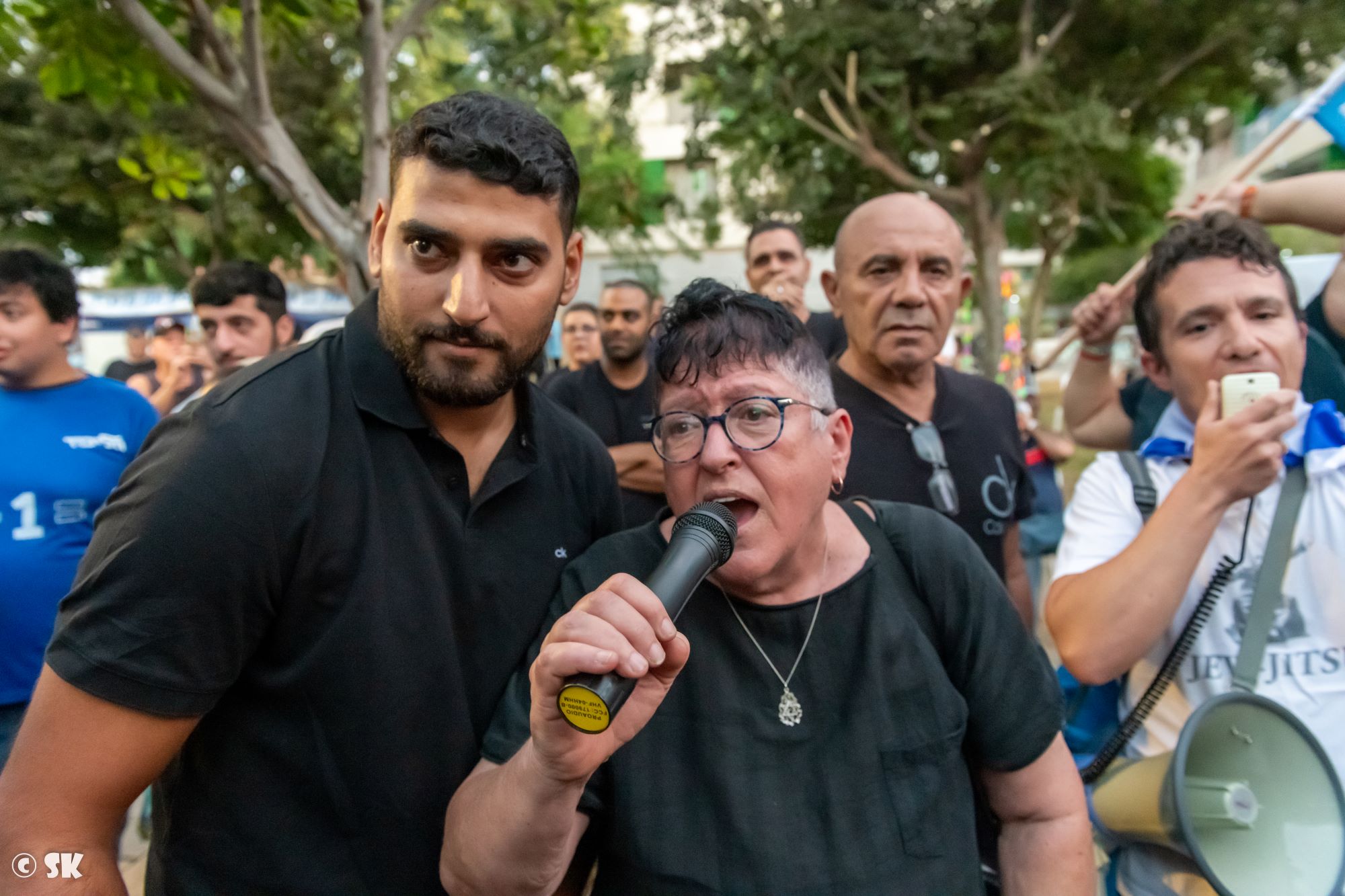
Upon arriving earlier in the afternoon, Paz and her entourage erected giant banners at the entrance to the park, featuring slogans such as “Warning! Infiltrator ahead,” and “We vote for deportation!” Paz is infamous for her extreme tactics — she was charged in 2020, for example, with invading a preschool for the children of asylum seekers — yet her rhetoric chimes with that of politicians at the highest levels of government who have been waging a war against African asylum seekers, who they commonly refer to as “infiltrators,” for more than a decade.
African asylum seekers began arriving in greater numbers to Israel’s border with Egypt in the late 2000s, most of them fleeing genocide in Sudan or torture and slave labor in Eritrea. Rather than considering their asylum claims, Israel for the most part simply offered them a one-way bus ticket to south Tel Aviv and a three-month residency permit to remain in the country, which they are required to continually renew upon expiry.
Successive government policies, meanwhile, have sought to make Israel so unlivable for this community that they have no choice but to leave “voluntarily.” These have included imprisoning asylum seekers in detention centers upon arrival; maintaining segregated schools for their children; deducting 20 percent of their salaries to be placed into a fund that they can only access upon departing the country; and barring them from working in certain professions in major cities. In 2018, Israel even attempted to forcibly deport tens of thousands of asylum seekers to Rwanda and Uganda, before strong local and international pressure forced a U-turn.
Whereas by 2012 there were more than 55,000 African asylum residing in Israel, the number has since fallen to under 30,000 as a result of the pressures against them. Today, some 10,000 live in neighborhoods of south Tel Aviv like Shapira, Neve Sha’anan, and Hatikva, which have become sites of tension between the asylum seekers and the veteran, mostly Mizrahi Jewish populations, who had experienced decades of neglect by the state.
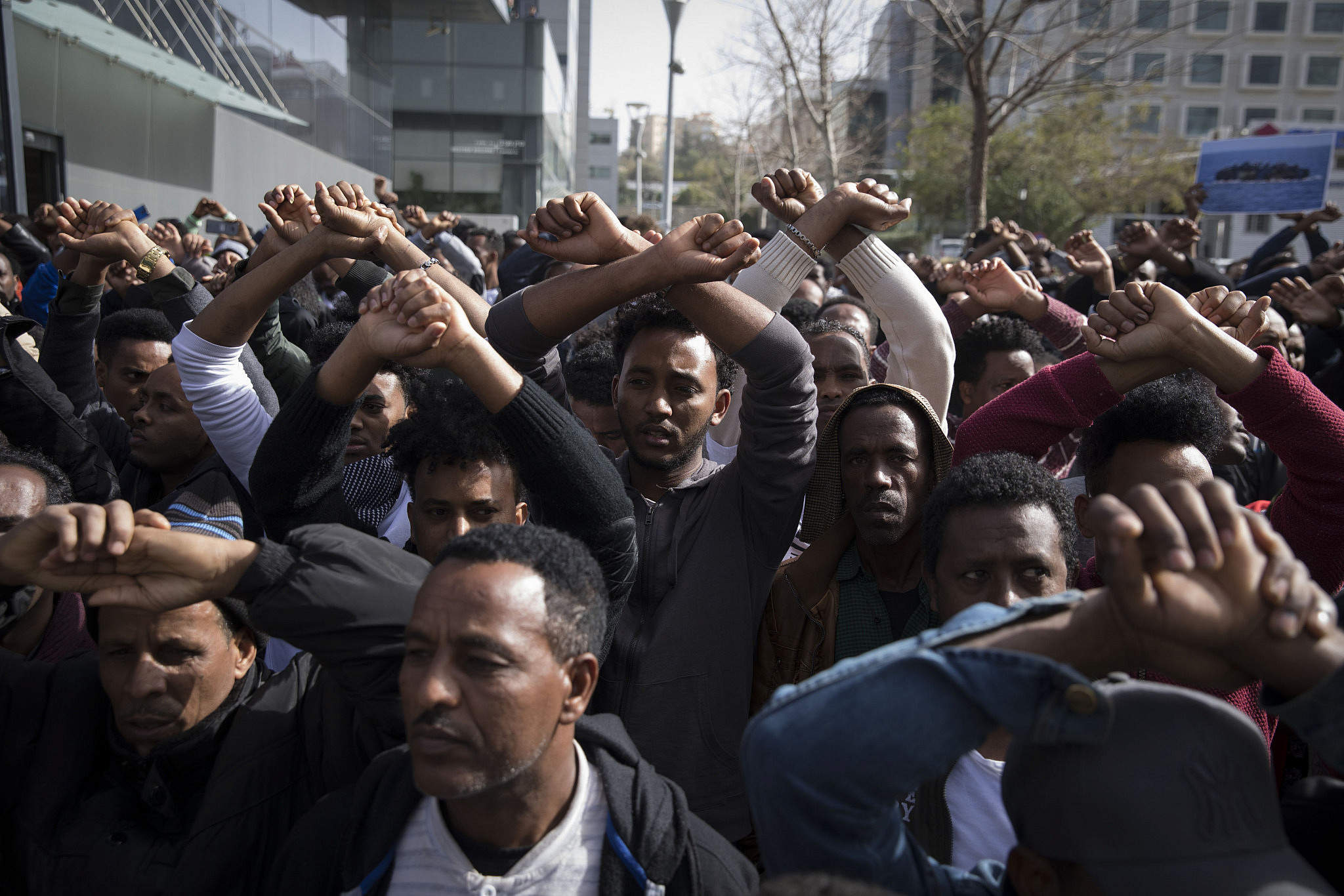
Displayed across the grass in De Modena Park last Wednesday were placards exhibiting statistics supposedly proving that asylum seekers were responsible for a spike in crime and rape across south Tel Aviv, alongside various graphic, decontextualized images of Black men lying wounded on the streets. One of Paz’s entourage remarked to an enquiring left-wing protester that these were the victims of violent attacks by fellow “infiltrators”; the manner in which individuals in the right-wing crowd waved these photos at the left-wing camp later clearly implied these were not shown out of sympathy, but as a threat.
‘We want to bring back the energy of solidarity’
The scene in the park 24 hours earlier could not have provided a starker contrast. Parents — Israelis and asylum seekers alike — were supervising their children as they played on the swings and the climbing frame. Locals were out walking their dogs and using the public gym equipment. It was quiet enough to hear a chorus of birds chirping. In one corner, a handful of activists sat on the grass with a group of young children from different communities, playing games, drawing, and making decorations to put inside the sukkah that had appeared in the park at the beginning of the holiday.
According to Merav Gann-Perkal, one of the activists involved in organizing the children’s activities in the days leading up to Ben Gvir’s event, this work was no less a part of confronting the MK’s message than the protest itself on Wednesday evening. The main goal, she told +972, was to warn the local children who play in the park, and their parents, to stay away from the area on Wednesday — which, for the most part, they did. But there was another aspect too: “We wanted to make sure the children know that there are people who stand with them, and that they are not alone.”
Paz has become well-known for frequenting this park and other public spaces used by the children of asylum seekers, and provoking them into a reaction that she then films and uploads to her YouTube channel. The activists were eager to make sure she wouldn’t have the opportunity to provoke anyone when bigger crowds of right wingers would be present in the park, nor to allow the children to be exposed to racism and violence. “I don’t trust the police to protect the children,” said Gann-Perkal.
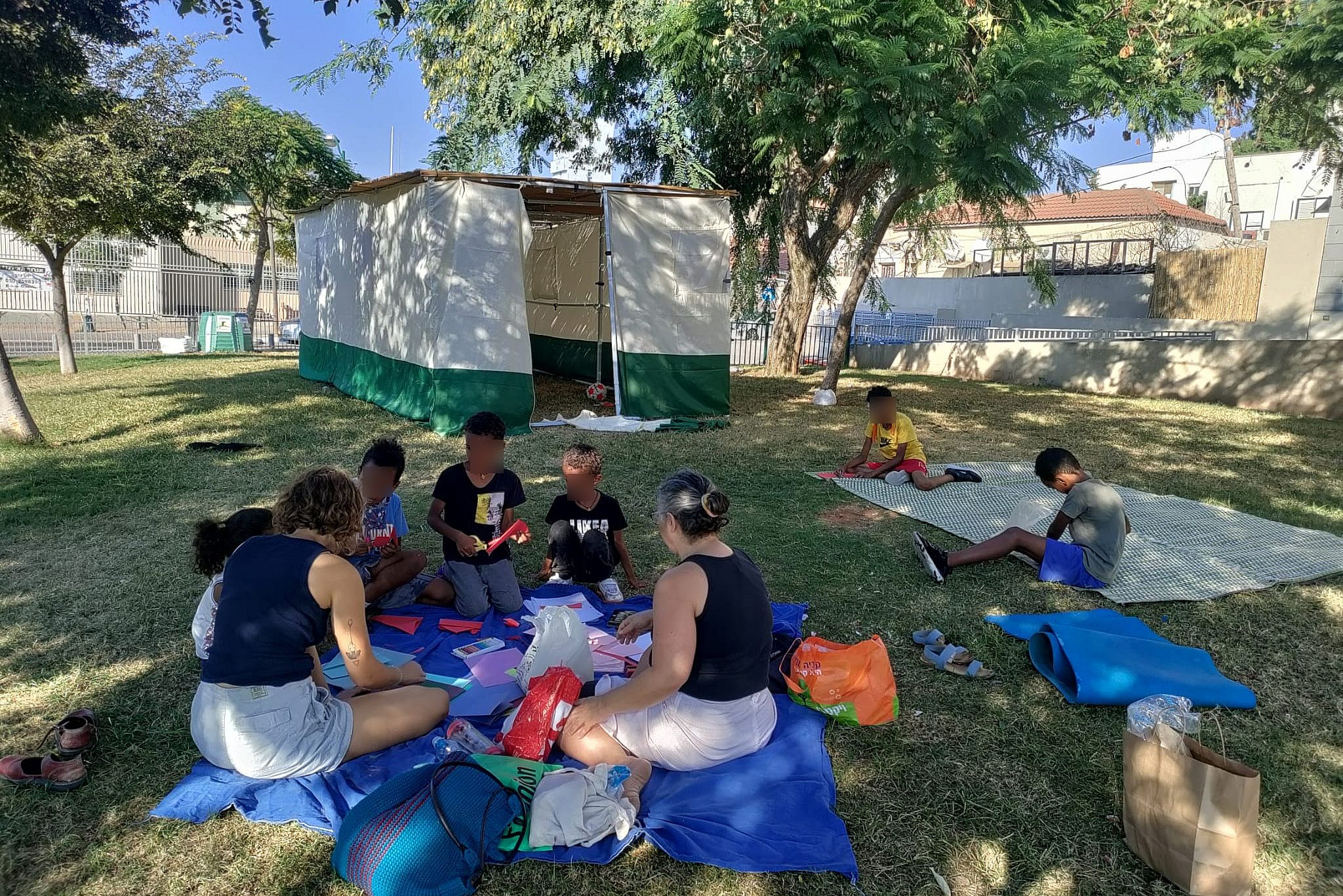
This was part of the plan that had taken shape over the course of several meetings at activists’ homes in Shapira in the days following the event announcement. “We reactivated the network from [the anti-deportation campaign of] 2018, and we want to revive that same political spirit,” Arielle Gordon, one of the organizers, told +972 ahead of the protest. “That spirit was dampened during COVID-19. 2020 was incredibly hard for the refugee community, which was grasping at straws and just trying to survive. We want to bring back the energy of political solidarity from the years before.”
Among the organizing team were activists who were heavily involved in the 2018 protests, and many who have worked or volunteered in NGOs that advocate for the rights of asylum seekers in Israel. One of those groups, Elifelet, was established in 2012 after a night of violence in Shapira in which Molotov cocktails were thrown at four houses and a kindergarten that served asylum seekers.
Comparisons with settler violence toward Palestinians in the occupied West Bank are hard to avoid, with both serving the state’s agenda of ethnic and racial supremacism, albeit with radically different scales and contexts. And anywhere that there is an undesired non-Jewish community — especially in areas where the population is heterogeneous, such as Jerusalem and the so-called “mixed cities” — Ben Gvir is fast making it his turf.
The activists utilized their connections with leaders of the local Eritrean and Sudanese communities to make sure everyone was aware that the event was happening and could prepare accordingly. They also coordinated with leaders from the local Scouts group, which mainly comprises the children of African asylum seekers and migrant workers from the Philippines. The Scouts had their own activities planned in another nearby location for the duration of Ben Gvir’s event, so the activists made sure the kids they met in the park prior to Wednesday knew they were welcome at those.

The protest itself was the final piece of the puzzle, and Gordon emphasized that they wanted to be present in large numbers from the moment Paz’s group arrived in the park, in order to further minimize the threat of violence against the asylum seeker community. “We will protect all members of our community, no matter who they are and where they came from,” she said.
(On the Saturday evening following Ben Gvir’s event, Paz and another individual found Gordon’s house, shouted curses at her, and took photographs. Paz later shared Gordon’s address with her more than 20,000 Facebook followers. Gordon told +972: “These harassment tactics haven’t intimidated us in the past, and they won’t work now.”)
‘Three weeks from now, things are going to change’
For most of Wednesday afternoon, the leftists outnumbered Ben Gvir’s supporters. They brought instruments — including a trombone that was blown tunefully every time Paz tried to speak into her megaphone — and made signs that bore slogans in support of refugees and against racism. For nearly an hour, Ethiopian music was blasted from DJ decks set up on a balcony overlooking the park. Delegations from political parties and established organizations also joined: first the Zionist-left Meretz, and later the communist Hadash and anti-occupation group Peace Now.
The right-wing group took a little longer to get organized. While preparing the sukkah, they blasted remixes of well-known religious pop songs on repeat out of a large speaker system. Every few minutes, the singing would give way to the same recording of a Ben Gvir speech in which he declared: “The Islamic movement won’t take the Negev or the Galilee from us.” By the time Ben Gvir came, their numbers had eclipsed those of the left-wing bloc, reaching nearly 200 people.
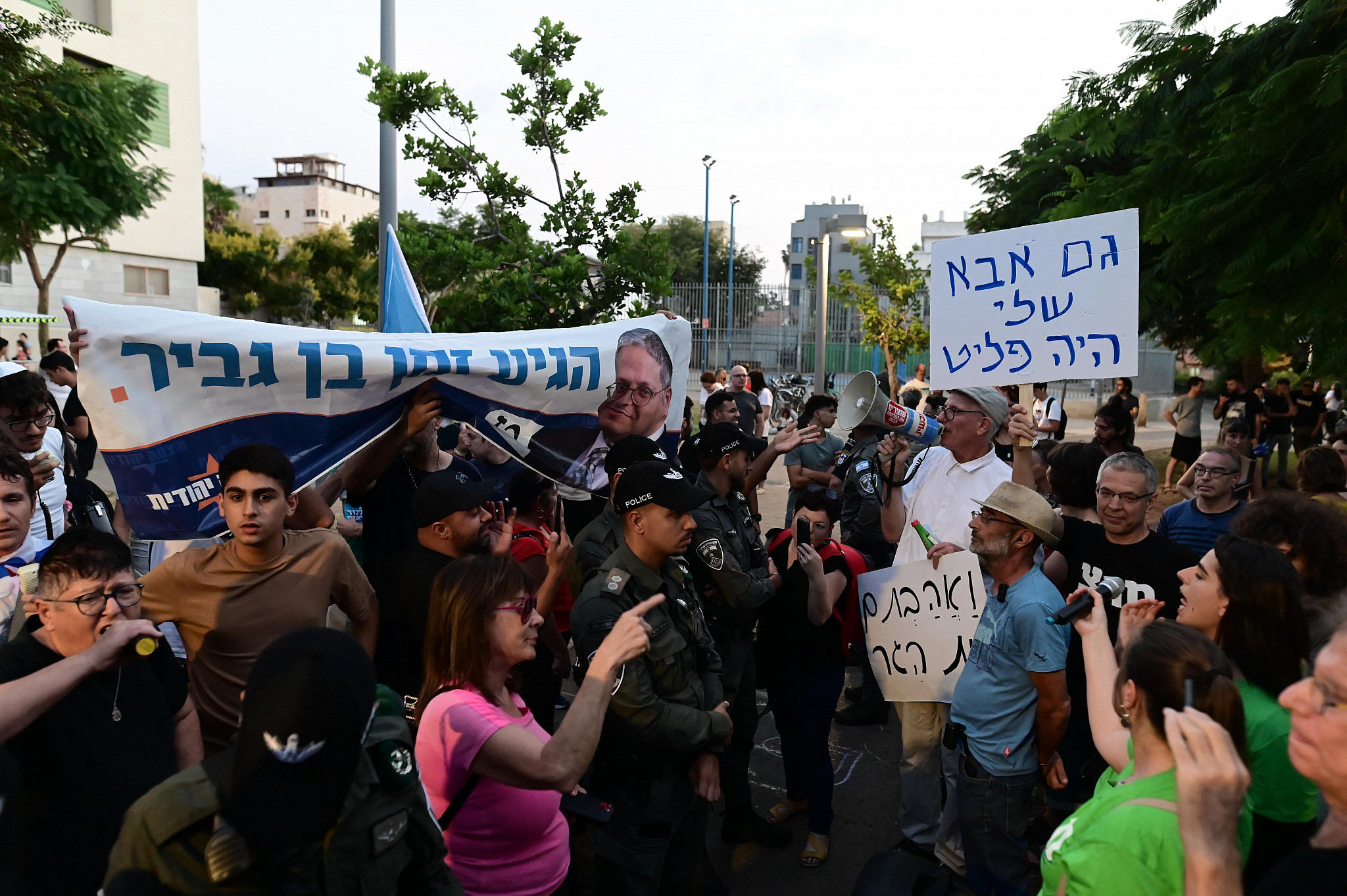
In terms of age, religiousness, and (Jewish) ethnicity, the right wingers were remarkably diverse — a testament to Ben Gvir’s appeal beyond the traditional sectorialism of Israeli politics. His supporters, for their part, highlighted what they saw as the hypocrisy of the mostly secular, Ashkenazi left-wing bloc, shouting at them to go back to their kibbutzim and white-only neighborhoods. And although the ostensible target of this specific event was the asylum seeker community, several Ben Gvir supporters also held signs bearing anti-Palestinian slogans.
Flags, T-shirts, and banners featuring the logo of Ben Gvir’s party, Otzma Yehudit (“Jewish Power”), were so ubiquitous that one could forget that the party is running on a joint ticket with another far-right party, National Union, under the name Religious Zionism. Nor was there any sense that it is actually National Union’s leader, Bezalel Smotrich, who is the head of this merger — despite the clear preference of their voter base.
Ben Gvir has made a point of “moderating” his image ahead of this election in order to appeal to a wider voter base. The photo of Baruch Goldstein, a settler who shot dead 29 Palestinians inside Hebron’s Ibrahimi Mosque in 1994, no longer hangs on his wall at home, and he has repeatedly tried to put some distance between himself and the legacy of his ideological mentor, Meir Kahane.
But some of his supporters seem not to have gotten the memo. One young man wearing an Otzma Yehudit T-shirt, who couldn’t have been much older than 18, paced up and down continuously in front of the leftist crowd, occasionally proclaiming into his megaphone in heavily American-accented Hebrew that “Rabbi Kahane was right.”
There was even a scattering of people wearing Likud T-shirts, who clearly did not feel out of place at an event for a man whose entry into the Knesset was engineered by Netanyahu himself (the two are now reported to be coordinating their campaign strategies for the final weeks before the election). One gets the feeling at an event like this, though, that even Netanyahu could not have foreseen the Kahanist’s astronomical rise.
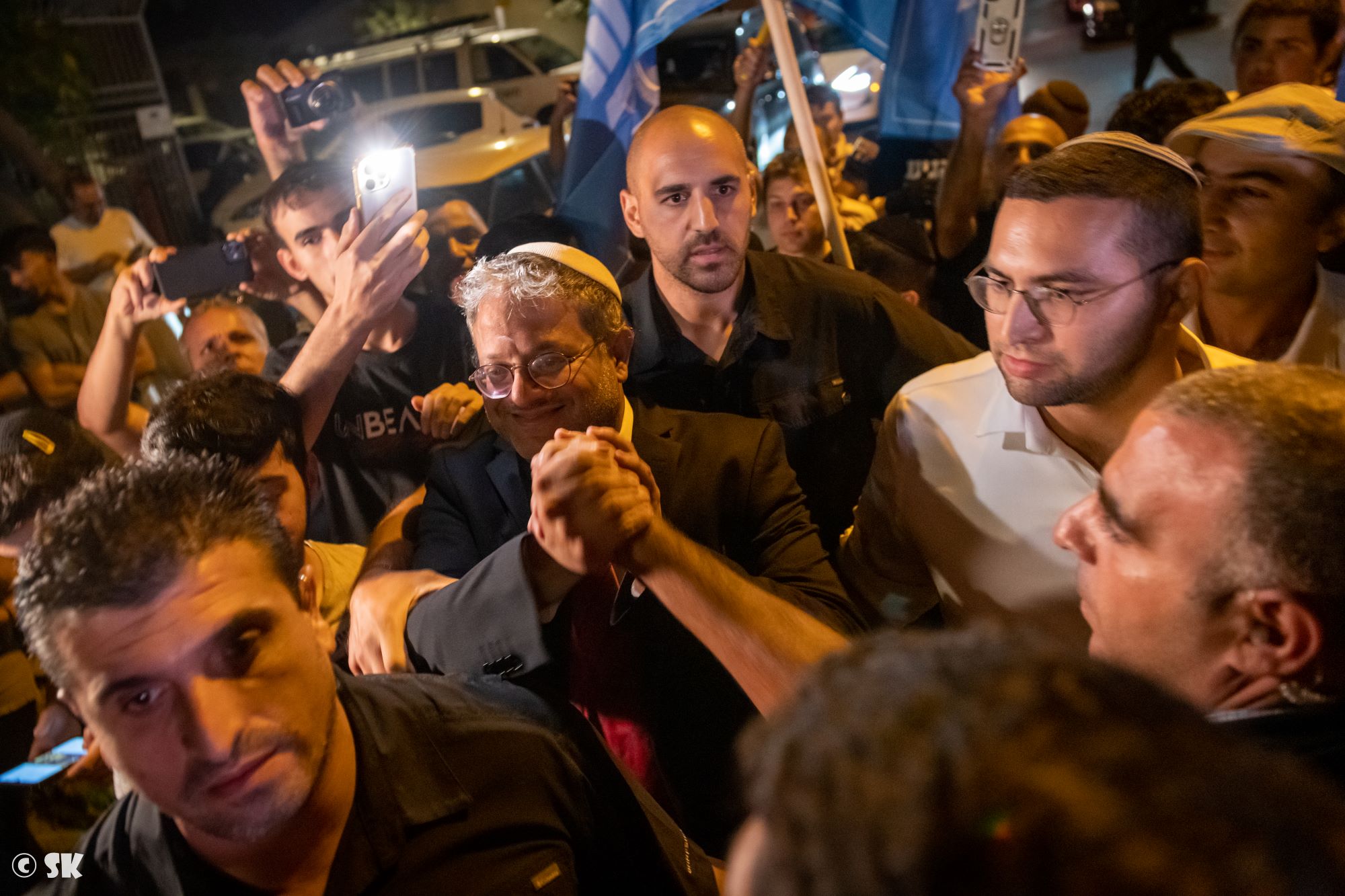
After all the hours of waiting, Ben Gvir’s visit to the park only lasted about 30 minutes. But that was enough for a hero’s welcome, prayers inside the sukkah, a brief speech in front of the left-wing crowd, and a procession accompanying him back to his car. His presence clearly emboldened his supporters, who repeatedly broke through the police tape separating them from the left-wing camp; a few were forcibly removed from the park by police as a result. During the MK’s speech, one of his supporters, wearing a red “Make America Great Again” cap, tried to grab a press microphone from journalists covering the event.
From the moment he appeared until the moment he was gone, Ben Gvir was totally surrounded by the adulating crowd; were it not for his characteristic white knitted kippah, it would have been almost impossible to spot him. “You’re shouting because you know that three weeks from now, things are going to change,” he told the crowd of left-wing protesters before he departed.
Ben Gvir’s appearance at De Modena Park was a major coup for Paz and her ilk, who would have been unable to mobilize even a fraction of the people who heeded the MK’s call on Wednesday evening. It also highlights the extent to which Ben Gvir now symbolically serves as commander-in-chief for all forms of Jewish supremacy in Israel, regardless of whether the targets are Palestinians or asylum seekers.
At the park, the slogan emblazoned across the Otzma Yehudit T-shirts and banners was simple but powerful: “Ben Gvir’s time has come.” On the evidence of this event, it’s hard to argue that they’re wrong.

